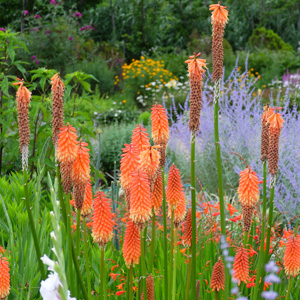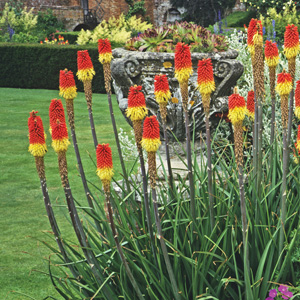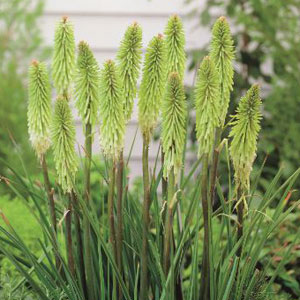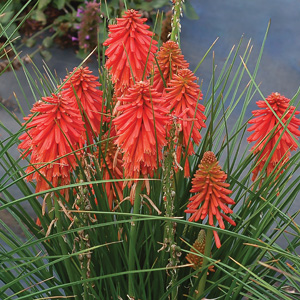Kniphofia Growing Guide

What is Kniphofia?
Kniphofia (Kniphofia spp.) also known as Red Hot Poker or Torch Lily is a compact clump forming perennial. They are part of the Asphodelaceae family where most of them came from South Africa as there are around 70 species. All species display in their own way their iconic bottle brush looking flower spike. Long flower stems shoot straight up from the basal clump, atop of which appears gloriously showy flower spikes that come in a variety of colours. The flower spikes can be in colours of red, orange, yellow, white or green or a combination of these colours on the one flower. The foliage emerges, from rhizomes, that is thin and strappy almost sword in appearance. Some varieties are evergreen while others are deciduous. Depending on the variety will depend of the flowing period. Kniphofia require a full sun position in your garden that has moist, humus-rich, well-drained soil. Most species are frost tolerant, though none will tolerate heavy frosts.
Benefits of Growing Kniphofia
Kniphofia are easy to grow and make great plants for the beginner gardeners because of their low maintenance and very easy to care for. They requiring low water and are drought, frost and wind tolerant making these plants a perfect choice for any garden. They can be relied upon to give great flowering results every year with their tall showy flowers. Kniphofia are ideal for borders, backdrops and along driveways. Their flowers make an excellent display in a vase and last for many weeks. The flower also attract Australian nectar feeding birds especially the Rosella, honey eater and wattle birds that dine on the tall striking flower heads.
How to Grow Kniphofia
Climatic Zones
Cool to Sub-Tropical.
Plant Size
Sizes vary.
When To Plant Kniphofia
Plant in Spring after the last frost.
Soil Preparation
They require free draining soil. They will not tolerate clay soils especially during the colder months. Plants will rot over winter if soil is boggy. Add plenty of mulch in colder Winter areas.
How To Plant Kniphofia
Plant in full sun to part shade, 1m apart with the plant crown at soil level.
Kniphofia Plant Care
Only water to supplement natural rainfall, particular during Summer.
Mulch to protect young plants from frosts.
Fertilise with a complete fertiliser in Spring. Can also use well broken down animal manure.
When pruning cut off dead flower stems after flowering has finished and remove any dead foliage. With the deciduous varieties, if the foliage has not died back at the start of Winter cut it back to the ground. Evergreen varieties can be trimmed back to half the leaf length at this time to keep in shape. This will encourage new healthy growth.
Propagation is easiest by division of established clumps. The best time to divide Kniphofia is in in Autumn or Spring. Lift the clump if possible with a garden fork. Use a sharp spade to to divide the clump and then replant. Do not divide clumps that have been planted for less than three years.
Pest Resistant.
Recommended Kniphofia Varieties
Kniphofia are a fantastic choice for the Australian garden. Not only are they hardy plants that have stunning showy flowers with a wide array of colours, they also attract native birds into your garden.










